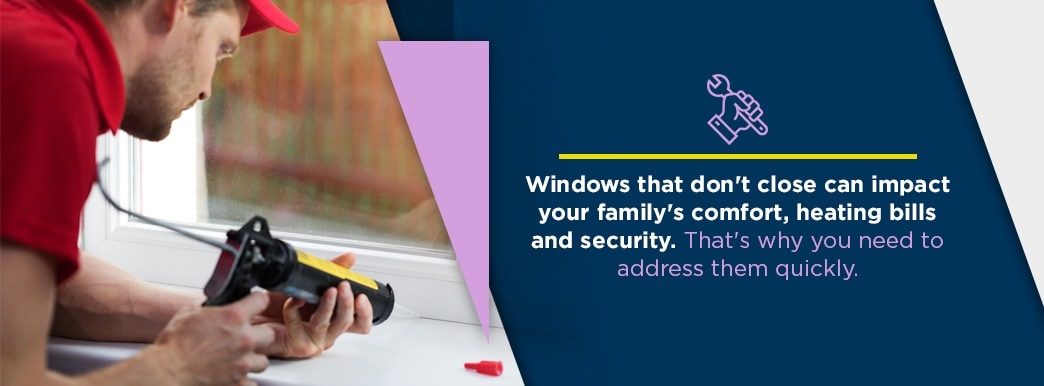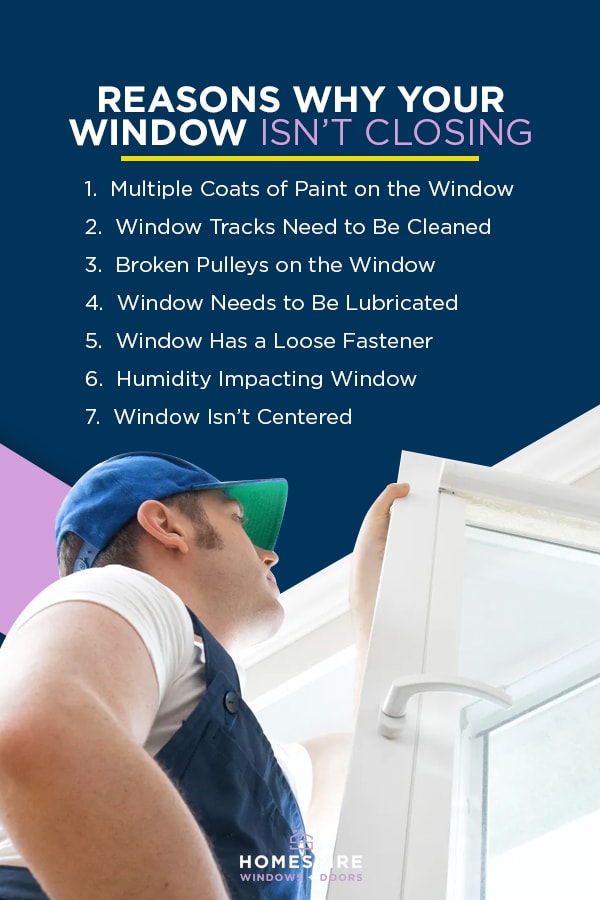Jump to:
- Why It’s Important to Fix a Window That Won’t Close ASAP
- Reasons Why Your Window Isn’t Closing
- What to Do If Your Window Won’t Move
Windows that don’t close properly can cause a massive spike or increase in your monthly heating bills. The small drafts of air that slip through those cracks can cause your house to be too cold for comfort. As seasons change and colder weather arrives, it will be crucial to keep your window closed and tightly sealed shut throughout the winter months.
Why It’s Important to Fix a Window That Won’t Close ASAP
Homespire Windows and Doors knows windows that don’t close can impact your family’s comfort, heating bills and security. That’s why you need to address them quickly. There are a few steps you can take to remedy minor issues, but many times minor issues are symptoms of larger problems that could be fixed with new, energy-efficent windows from Homespire Windows and Doors.
If your window fails to close properly, it renders your home’s interior vulnerable to drafts from outside wind during the fall and winter months. This can make your living situation rather uncomfortable, especially as the weather gets cold and robs your living quarters of vital heat and energy efficiency. That’s why Homespire Windows and Doors installs windows with maximum efficiency.
Even if your draft is paper-thin, the loss of insulation could put a huge drain on your heating system:
- When the weather drops below freezing, you could find yourself relying much more heavily on your heater to compensate for the loss of natural insulation.
- You could pay higher energy bills throughout the winter months, all due to an air draft caused by faulty windows.
Each window plays a crucial role in your home’s security, as we well know at Homespire Windows and Doors. The most dangerous consequence of a window that won’t close is how it could make your home vulnerable to a break-in. If the window sits at ground level, a passerby might notice the issue.
Burglars often know how to spot a loose or easy-to-enter window. After all, if a window will not close entirely, then it most likely cannot be locked. Someone can probably raise the window from the outside just as easily as from the inside. Knowing this, an intruder could target your home for burglary or possibly worse.
Reasons Why Your Window Isn’t Closing
If your window is not closing properly, you can likely attribute the stuck window to one of several common issues, such as humidity, dirtiness, or difficulties with the tracks. While some problems require replacing the window, others can be fixed as long as no serious issue develops. The most common reasons a window can get stuck open include the following:
1. Multiple Coats of Paint on the Window
When an older window fails to close properly, one of the most likely culprits is the paint. If you have painted the stiles and jambs numerous times over the years, these multiple paint layers will inevitably add to the thickness of the frame parts. Since the frame was designed to snugly fit into its corresponding slots, the added paint layers could corrupt the integrity of the original fit.
Even if the window has only had one or two layers added to the original coat, there could still be certain spots that might cause sticking points. For example, the outer coat could appear fine on the outside, yet there might be a hardened drip on some hard-to-see spot causing the window to stick as you shut it.
An overly painted window can also get stuck if you leave it in a set position for a prolonged period through several warm and cold season cycles. In older houses, you will sometimes see windows that look and feel as though they were painted shut. In fact, the effects of moisture caused the underlying wood to expand and contract too many times.
Another paint-related issue is the problem of cracks, which can hinder the window’s movement. If these cracks turn into ruptures, they could impede the up-and-down movement of the stiles or the closed fitting of the lower sash. Of course, you can avoid the issue of faded paint by installing composite windows from Homespire Windows and Doors.
2. Window Tracks Need to Be Cleaned
The easiest issue to fix when it comes to a stuck window is a set of dirty tracks. If the tracks are lined with dirt and gunk, this will prevent the movement as you raise and lower the window. Dirt can make its way into the tracks when you leave the window open during the summer months. While it typically occurs in a slow and subtle manner, wind can kick dirt particles into the air and allow elements of dirt to deposit and stick in your window tracks.
Even more troubling is the buildup of gunk, which forms from a mixture of:
- Dirt
- Oil
- Moisture
- Other foreign elements
As gunk cakes up within the window tracks, it could cause the window to get stuck at certain points as you move it up and down.
In some cases, the dirt inside the tracks of a window can be more cumbersome than normal, especially if you have not paid attention to this area. For example, if you clean the tracks for the first time in three years, you might be surprised to discover the presence of foliage, twigs, pebbles, or small debris.
For obvious reasons, a window will not open or close properly when the tracks are clogged. You must clean the tracks on a regular basis during the months when you leave the windows open to the outside breeze.
3. Broken Pulleys on the Window
If your window is equipped with pulleys, they will need to be fully intact in order for the window to open and close properly. Broken pulleys are a common problem in older houses and apartments.
When the pulleys are broken, the window could feel a lot heavier than normal when you try to open it to any given height. The moment you let go of the window, it might fail to hold. Whether the window slowly slides back down or comes crashing down with a thud, you could have a dangerous situation on your hands, especially if the window is situated two or more stories above the ground.
Pulleys can wear down over a period of many years due to the effects of time and the elements. Metal pulleys can rust and lose their ability to turn smoothly and evenly. If the cords snap, your window will lack the support it needs to move up and down on the tracks properly.
As long as you can find pulleys that match the ones in your window, you could swap them out for clean, new pulleys that could have your window opening and closing like before. Otherwise, replacement windows might be the better and easier option. In that case, be sure to find a company like Homespire Windows and Doors that offers a Signature Warranty that covers replacement parts.
4. Window Needs to Be Lubricated
A window can get stuck halfway or fail to move up and down if the tracks lack proper lubrication. The problem is due to the friction when two metal parts rub against one another. Without lubrication, there is nothing to grease the skids and prevent the occurrence of friction.
Tracks without lubrication could also be vulnerable to rust and corrosion. If the lubricants are old and spoiled, impurities could form in the dried lube residue. As you continue to force the window up and down, these impurities could spread along the tracks and further hinder the functionality of the window.
Thankfully, lubrication issues are among the easiest problems to remedy:
- If the tracks become unyielding, apply lubricant in a few key spots along the vertical inner-length of the window on both sides.
- As you slide the window up and down, the movement should quickly become easier and smoother as the lubricant spreads along the tracks.
- Before you apply new lubricant, wipe away any old and stale coats that might still be on the window tracks.
- Make sure the tracks are clean and free of dirt, gunk, or debris, as these will hinder the movement of your window, regardless of the lubrication quality.
5. Window Has a Loose Fastener
When a window fails to close properly, it is almost impossible to get the fastener to function. If you can barely get the window to seal shut, you might not be able to get the fastener to engage with its connecting part. For example, if the window closes with a latch, the lock will probably not engage if the window is even slightly ajar when you try to close it.
One of the more confusing problems is when you cannot tell whether the window has closed completely. If the lower sash enters the stile, it might appear as though the window has shut. However, a gap could remain at the bottom, and this would make it difficult, if not impossible, for the fastener to turn.
Another problem occurs when the fastener becomes loose and fails to secure your window in the locked position. This could put your house in danger, especially when the window sits at ground level. Consider these situations:
- Often loose fasteners are the result of expansions within the corresponding metal parts, which make it impossible for the two ends to grip.
- If the window closes slightly ajar on numerous occasions or the fastener gets abruptly yanked and pulled, it could bend the fastener parts out of shape and render them ineffective and unsafe.
6. Humidity Impacting Window
If your home is subject to extreme changes in seasonal conditions, the wood that surrounds your windows could expand and contract over time. When the weather is exceedingly hot, the stiles and jambs expand due to vapors absorbed into the grains.
Even if the expansion is barely a millimeter in difference, it could render the stiles too thick or the jamb tracks too tight to accommodate movement and allow the window to close properly. After all, window frames are designed to be snug to prevent the passage of wind and the loss of insulation.
If you notice your windows only work on an occasional basis, this could represent different stages of the expansion and contraction effects of different temperature extremes. While the window frames will not be exposed to heat during the winter months, the panes of glass could still attract moisture. This is due to the inability of cold air to hold vapor, unlike hot air, which allows vapor to circulate.
When cold air comes into contact with cold objects, the latter attract air-bound moisture. Glass panes and anything nearby are generally the coldest parts of a house in the wintertime. They are magnets for moisture. Windows get exposed to the expansion and contraction effects of humidity and moisture for about six months out of each year.
One of the best ways to combat changing weather is to install windows that are specifically made to suit your local climate. Homespire Windows are made in Pennsylvania and designed to withstand the hot, humid summers and cold winters of the Mid-Atlantic region.
7. Window Isn’t Centered
A window will not move up and down properly if it is not correctly aligned within its tracks. If the window is slightly ajar when fully open, its angle will become more awkward as you attempt to bring it down to closed position.
A window can gradually lose its alignment if you repeatedly apply excessive force when you slide it open and shut. If the pulley breaks on one side, the window will lose its support on that side. Consequently, the stile could slant against that side when you open the window. Each time you raise and lower the window, the problem could become more pronounced and difficult. Lopsidedness can also occur if the inner tracks get dented or bent on one side of the window.
Sometimes you can adjust a window back into a centered position. But the problem often indicates more serious damage you can only remedy with an entirely new window from Homespire Windows and Doors.
What to Do If Your Window Won’t Move
If your window won’t open or shut, try using these steps to remedy the situation:
- The easiest problem to rectify is a dirty window track, which you can clean with towels and brushes. If you have a canister vacuum on hand, use that to clear lingering dirt from the sliding tracks. This way, you remove dirt and foreign objects that you might not otherwise spot with the naked eye.
- If the window gets stuck in its tracks, lube the tracks with candle wax or beeswax. This should loosen up the skids and allow the window to move up and down more freely. If you have a vinyl window that gets stuck as you move it up and down, apply silicone spray along the stiles and jambs.
- If one of the fasteners on the window becomes loose, tighten the fastener with an applicable tool and test the window to see whether everything remains intact. If the fastener pops out again, the problem might be due to a stripped fastening hole. In that case, use a wood-filling product to tighten the hole and refasten the part.
- If the window appears tilted to one side while open, you can try to adjust it to a horizontal position manually. With both hands along the top sash, pull up on the slouched side while pushing down on the other side. If you get the window flat, move it up and down to see whether it will stay even. If so, the window might suffice for the meantime. However, problems such as this may stem from more serious issues that generally necessitate new windows.
Get Replacement Windows From Homespire Windows and Doors
While you can sometimes fix small and minor window problems, often the best choice is to buy a new window. Homespire Windows and Doors sells replacement windows in a variety of styles, including double-hung, sliding, casement, and bay. Explore our website for more information and contact Homespire Windows and Doors with questions today.
Get 20% Off
PLUS
No Deposit, No Payments, and No Interest for 12 Months*
*By completing the form, I consent to have Homespire Windows and its affiliates contact me to verify my information, schedule an appointment, or inform me of future product updates, which may include marketing. I consent to receive calls or texts that use automated technology or a pre-recorded voice at the phone number(s) provided. Consent is not required to receive goods and services. I can call the phone number found at the top of this web page. Please see our Terms & Conditions. Msg & data rates may apply.




